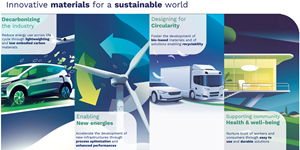Nanotech 2004: Progress toward commercialization
The Nanotech 2004 conference in Boston unites many disciplines.
The Nanotech 2004 conference (Boston, Mass., U.S.A., March 7-11) was hosted by the Nano Science and Technology Institute (NSTI, Cambridge, Mass., U.S.A.), an interdisciplinary consultancy focusing on all aspects of nanotechnology. The conference mission is to provide "for a single interdisciplinary integrative community, allowing for core scientific advancements to disseminate across the breath of traditional science and technology domains."
Since the common thread for attendees was very small size, event participants came from diverse backgrounds. Electronics, health sciences, and material disciplines each contributed a quarter of the 2000+ attendees, with the automotive, energy and defense industries providing the balance. Half the attendees came from outside the U.S.
The keynote address was delivered by Dr. Clayton Teague, director of the National Nanotechnology Initiative (NNI), an interagency effort aimed at maximizing return on the U.S. federal government's investment in nano-scale R&D. The 2004 federal budget for Nanotechnology is $961 million (USD) - double that spent in 2001. And the U.S. Congress overwhelmingly passed a bill authorizing $3.7 billion for fiscal years 2005 through 2008, 69 percent to be spent turning research into commercialized products.
Nanotech has been defined as technology at less than 100 nanometers (nm), having new functions due to this small size. A nanometer is one billionth of a meter - so small that often the laws of quantum mechanics displace classical Newtonian physics. This, coupled with their extremely high surface-to-volume ratios (as much as 1:5), can lead to unusual characteristics. For example, a carbon nanotube can be created to be either metallic or superconducting. Metals get stronger and harder, while ceramics get tougher and more ductile as their grain size shrinks to the nanoscale.
Nanoparticles, nanofibers, nanotubes and fullerenes are a few examples of what makes up this new world. Nanoparticles are simply particles with diameters in the 1 nm to 100 nm range. Nanofibers are electro-spun whiskers with diameters in the 10 nm to 100 nm range and length-to-diameter ratios of 1,000+. Carbon nanotubes, the most well-known nanotubes, are made up of carbon atoms arranged in a hexagonal pattern and resemble thin cylinders of chicken wire. They can be single-walled or multi-walled. Fullerenes are closed cages of carbon atoms. For example, the C60 fullerene (a/k/a "buckyball") is composed of 60 carbon atoms in a soccer ball shape.
Nanoscale technologies have the potential to revolutionize material science. Venture capitalists call them "disruptive technologies" that will modify some industries and technologies and replace others.
Nanoscale technologies are not yet ready to plug-and-play in composite laminates, but several products are making their way to market or are available for development in advanced composites applications, such as improved catalysts for resin systems, nanoporous particles, which will increase adhesive bonds, and several types of nanoparticles that are available as additives to increase mechanical properties, such as wear resistance, conductivity, flame retardance, stiffness and strength.
Triton Systems (Chelmsford, Mass.) offers technology development services in nanomaterials, polymers and composites. An example is an elastomeric nanocomposite barrier material Triton developed with SBIR funding as a flexible fuel tank for the military, and then commercialized for Converse sneakers.
Firstnano (Carpinteria, Calif., U.S.A.) offers a turnkey nanotube fabricationsystem called "EasyTube." CVD Equipment Corp. (Ronkonkoma, N.Y., U.S.A.) offers scalable custom equipment. Seki Technotron (Tokyo, Japan and Sunnyvale, Calif., U.S.A.) offers plasma deposition systems for both diamond and NT manufacturing. These machines start at about $80,000 to $100,000 (USD).
Cabot Corp. (Billerica, Mass.) provides nanoparticle solutions to customers. A new class of materials is Cabot's hydrophobic silica nanoparticle material called Aerogel. Aerogel can be used in thermal and acoustic insulation, or in adhesives and coatings for anti-sag, rheology control, water repellence, or gloss reduction.
Nano-C (Westwood, Mass.) presented its combustion synthesis technology for making fullerenes, which founder Gordon Fowler claims will take the price of the pure C60 down from $10,000/lb to $200/lb. Nano-C also provides application and commercialization support for fullerene derivatives.
Frontier Carbon Corp. (FCC, Tokyo, Japan) is a joint venture of Mitsubishi Chemical, Mitsubishi Corp. and Nanotech Partners (a private equity firm). FCC displayed its line of carbon fullerenes under the trade name Nanom, reported to increase the stiffness of epoxy resin by 15 percent and the strength by 10 percent at a 1.5 percent concentration, and can increase the thermal stability of resins. Prices are estimated to be less than $5/gram (USD) and product will be available in the U.S. later this year from Mitsubishi International Corp.
Molecular Diamond Technologies (Richmond, Calif., U.S.A.) a Chevron Texaco startup, presented its work on the development of several shapes of diamondoid crystals. The crystals are available in large quantities, can be functionalized or doped to replace a carbon atom with, for example, nitrogen or oxygen, and are rigid, durable, hard, heat resistant and highly thermally conductive.
Nanometrix (Montreal, Quebec, Canada) offers technology capable of producing monolayers of 1 nm to 500 nm thick in unlimited roll lengths. The process can accept many substrates, including epoxy film, mylar and plastic, and many particle sizes and types. and produces a much thinner layer than standard web technology. The company is seeking to scale up and sell its machines, but is currently producing the films in 12-inch widths for customers.
Zyvex (Richardson, Texas, U.S.A.) claims that its formulations using carbon nanotubes have doubled the strength, quintupled the strain and increased the conductivity of polymers 1,000 fold. Reportedly, Zyvex can tailor nanotube function for improved adhesion and compatibility to matrix materials.
Since the stiffness of carbon nanotubes is quoted in tera-pascals, the advanced composites industry will certainly be putting more effort into serious R&D. With federal funding providing an additional incentive, commercialization of these new products is expected in the next few years.
Related Content
Henkel releases digital tool for end-to-end product transparency
Quick and comprehensive carbon footprint reporting for about 58,000 of Henkel’s adhesives, sealants and functional coatings has been certified by TÜV Rheinland.
Read MorePontacol thermoplastic adhesive films are well-suited for composite preforms
Copolyester- and copolyamide-based adhesive films eliminate the need for sewing threads or binders when stacking laminates while improving the final part’s mechanical properties.
Read MoreResins, additives, adhesives and 3D printing solutions
CAMX 2023: Arkema’s broad portfolio of products for composites fabricators aim to enhance performance, durability and sustainability.
Read MorePark Aerospace launches aerospace, MRO structural film adhesive
Aeroadhere FAE-350-1 is a curing epoxy formulation designed for composite, metal, honeycomb and hybrid applications.
Read MoreRead Next
Plant tour: Daher Shap’in TechCenter and composites production plant, Saint-Aignan-de-Grandlieu, France
Co-located R&D and production advance OOA thermosets, thermoplastics, welding, recycling and digital technologies for faster processing and certification of lighter, more sustainable composites.
Read MoreDeveloping bonded composite repair for ships, offshore units
Bureau Veritas and industry partners issue guidelines and pave the way for certification via StrengthBond Offshore project.
Read MoreVIDEO: High-volume processing for fiberglass components
Cannon Ergos, a company specializing in high-ton presses and equipment for composites fabrication and plastics processing, displayed automotive and industrial components at CAMX 2024.
Read More













.jpg;maxWidth=300;quality=90)







